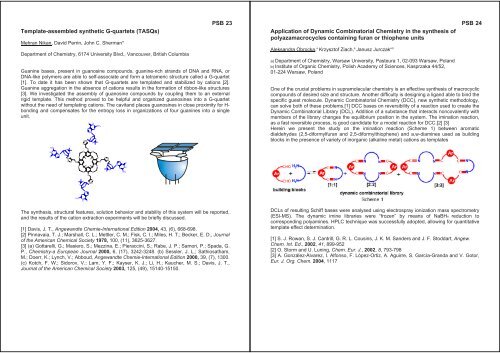ISMSC 2007 - Università degli Studi di Pavia
ISMSC 2007 - Università degli Studi di Pavia
ISMSC 2007 - Università degli Studi di Pavia
You also want an ePaper? Increase the reach of your titles
YUMPU automatically turns print PDFs into web optimized ePapers that Google loves.
Template-assembled synthetic G-quartets (TASQs)<br />
Mehran Nikan, David Perrin, John C. Sherman*<br />
Department of Chemistry, 6174 University Blvd., Vancouver, British Columbia<br />
Guanine bases, present in guanosine compounds, guanine-rich strands of DNA and RNA, or<br />
DNA-like polymers are able to self-associate and form a tetrameric structure called a G-quartet<br />
[1]. To date it has been shown that G-quartets are templated and stabilized by cations [2].<br />
Guanine aggregation in the absence of cations results in the formation of ribbon-like structures<br />
[3]. We investigated the assembly of guanosine compounds by coupling them to an external<br />
rigid template. This method proved to be helpful and organized guanosines into a G-quartet<br />
without the need of templating cations. The cavitand places guanosines in close proximity for Hbon<strong>di</strong>ng<br />
and compensates for the entropy loss in organizations of four guanines into a single<br />
unit.<br />
H2N N<br />
HN<br />
N<br />
O<br />
N<br />
O<br />
O<br />
O<br />
N<br />
N N<br />
O<br />
O<br />
O<br />
H 2N<br />
O<br />
O H<br />
N<br />
NH2 N N<br />
N<br />
O<br />
O<br />
N N<br />
N<br />
O<br />
O<br />
O<br />
O<br />
N<br />
H<br />
R<br />
O<br />
R R<br />
O<br />
N<br />
O<br />
N N<br />
O<br />
R<br />
O<br />
O<br />
N<br />
N N<br />
O<br />
O<br />
O<br />
N N<br />
N<br />
O<br />
O<br />
O<br />
N<br />
N<br />
N<br />
NH<br />
The synthesis, structural features, solution behavior and stability of this system will be reported,<br />
and the results of the cation extraction experiments will be briefly <strong>di</strong>scussed.<br />
O<br />
NH 2<br />
PSB 23<br />
[1] Davis, J. T., Angewandte Chemie-International E<strong>di</strong>tion 2004, 43, (6), 668-698.<br />
[2] Pinnavaia, T. J.; Marshall, C. L.; Mettler, C. M.; Fisk, C. I.; Miles, H. T.; Becker, E. D., Journal<br />
of the American Chemical Society 1978, 100, (11), 3625-3627.<br />
[3] (a) Gottarelli, G.; Masiero, S.; Mezzina, E.; Pieraccini, S.; Rabe, J. P.; Samori, P.; Spada, G.<br />
P., Chemistry-a European Journal 2000, 6, (17), 3242-3248. (b) Sessler, J. L.; Sathiosatham,<br />
M.; Doerr, K.; Lynch, V.; Abboud, Angewandte Chemie-International E<strong>di</strong>tion 2000, 39, (7), 1300.<br />
(c) Kotch, F. W.; Sidorov, V.; Lam, Y. F.; Kayser, K. J.; Li, H.; Kaucher, M. S.; Davis, J. T.,<br />
Journal of the American Chemical Society 2003, 125, (49), 15140-15150.<br />
Application of Dynamic Combinatorial Chemistry in the synthesis of<br />
polyazamacrocycles containing furan or thiophene units<br />
Aleksandra Obrocka, a Krzysztof Ziach, a Janusz Jurczak a,b<br />
a) Department of Chemistry, Warsaw University, Pasteura 1, 02-093 Warsaw, Poland<br />
b) Institute of Organic Chemistry, Polish Academy of Sciences, Kasprzaka 44/52,<br />
01-224 Warsaw, Poland<br />
PSB 24<br />
One of the crucial problems in supramolecular chemistry is an effective synthesis of macrocyclic<br />
compounds of desired size and structure. Another <strong>di</strong>fficulty is designing a ligand able to bind the<br />
specific guest molecule. Dynamic Combinatorial Chemistry (DCC), new synthetic methodology,<br />
can solve both of these problems.[1] DCC bases on reversibility of a reaction used to create the<br />
Dynamic Combinatorial Library (DCL). Ad<strong>di</strong>tion of a substance that interacts noncovalently with<br />
members of the library changes the equilibrium position in the system. The imination reaction,<br />
as a fast reversible process, is good can<strong>di</strong>date for a model reaction for DCC.[2] [3]<br />
Herein we present the study on the imination reaction (Scheme 1) between aromatic<br />
<strong>di</strong>aldehydes (2,5-<strong>di</strong>formylfuran and 2,5-<strong>di</strong>formylthiophene) and a,w-<strong>di</strong>amines used as buil<strong>di</strong>ng<br />
blocks in the presence of variety of inorganic (alkaline metal) cations as templates<br />
DCLs of resulting Schiff bases were analysed using electrospray ionization mass spectrometry<br />
(ESI-MS). The dynamic imine libraries were “frozen” by means of NaBH4 reduction to<br />
correspon<strong>di</strong>ng polyamines. HPLC technique was successfully adopted, allowing for quantitative<br />
template effect determination.<br />
[1] S. J. Rowan, S. J. Cantrill, G. R. L. Cousins, J. K. M. Sanders and J. F. Stoddart, Angew.<br />
Chem. Int. Ed., 2002, 41, 899-952<br />
[2] O. Storm and U. Luning, Chem. Eur. J., 2002, 8, 793-798<br />
[3] A. González-Álvarez, I. Alfonso, F. López-Ortiz, A. Aguirre, S. García-Granda and V. Gotor,<br />
Eur. J. Org. Chem. 2004, 1117

















